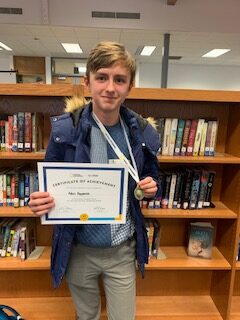The results are in! The National Geographic Society named Aden Rapanos, 8th Grade Student at North Rockford Middle School, as one of the semifinalists eligible to compete in the 2020 National Geographic GeoBee State Competition. The contest will be held at Western Michigan University—Fetzer Center in Kalamazoo on Friday, March 27, 2020.
This is the second level of the National Geographic GeoBee competition, which is now in its 32nd year. To determine each school champion, GeoBee competitions were held in schools throughout the state with students in the fourth through eighth grades. This year, an estimated 2.4 million students competed in the GeoBee, with 8,661 students becoming school champions. School champions also took an online qualifying test, which they submitted to the National Geographic Society. Up to 100 of the top-scoring students in each of the 50 states, the District of Columbia, Department of Defense Dependents Schools and U.S. territories were invited to compete in the State GeoBees.
State champions will receive a medal, $1,000 in cash, and other prizes, as well as a trip to Washington, D.C., to represent their state in the National Championship where they will compete for additional cash, awards and college scholarships. The second- and third-place State GeoBee winners will receive cash awards of $300 and $100, respectively.
How would you fare as a National Geographic GeoBee contestant? At the school GeoBees this year, students had to answer questions like these:
- Which state is located west of Lake Huron—Minnesota or Vermont? (Minnesota)
- Known for the tree nuts resembling deer eyes, which midwestern state is called the Buckeye State—California or Ohio? (Ohio)
- A savanna elephant’s daily amount of dung contains more than 3,000 seeds. Savanna elephants can be found in Namibia and Mozambique on what continent? (Africa)
- Volcanic activity under Yellowstone National Park creates great spouts of heated water that erupt out of the ground. These water eruptions are called what—geysers or cyclones?(geysers)
- Which country does not border the Atlantic Ocean—Moldova, Angola, or Ireland? (Moldova)
- The ancient Babylonians of Mesopotamia developed an early example of what basic counting machine that is still in use today—abacus or sundial? (abacus)
- Host of the 1984 Winter Olympics, Sarajevo is the most populous city in which European country that was once a part of Yugoslavia? (Bosnia and Herzegovina)
- Once the western terminus of the Northern Pacific Railroad, Tacoma is a major port and industrial city in which northwestern state? (Washington)
- Government designated preserves have helped protect giant tortoises in the Seychelles, a country made up of over one hundred islands located north of Madagascar in what ocean? (Indian Ocean)
- The Matterhorn is an iconic peak in the Alps on the border between Switzerland and what other country? (Italy)
Developed by the National Geographic Society in 1988 to promote geographic knowledge among young people in the United States, the National Geographic GeoBee is an academic competition for public schools, private schools and homeschools in the United States and its territories, as well as the Department of Defense Dependents Schools. Students in grades four through eight from nearly 10,000 schools participate annually for a chance to win college scholarships and the glory of being the National Geographic GeoBee Champion. Over more than three decades, 120 million students have learned about the world by participating in the GeoBee.
The National Geographic Society is a global nonprofit organization that uses the power of science, exploration, education and storytelling to illuminate and protect the wonder of our world. Since 1888, National Geographic has pushed the boundaries of exploration, investing in bold people and transformative ideas, providing more than 14,000 grants for work across all seven continents, reaching 3 million students each year through education offerings, and engaging audiences around the globe through signature experiences, stories and content. To learn more, visit www.nationalgeographic.org or follow us on Instagram, Twitter and Facebook.
###


